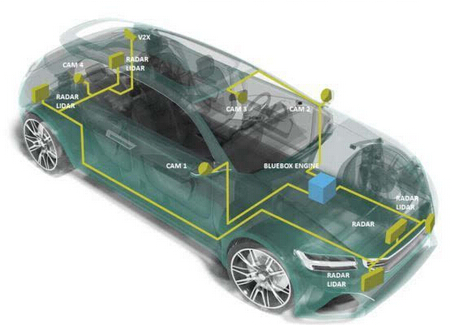The far-away unmanned vehicle technology has recently appeared frequently in the news, making you feel that this technology far from the horizon may be close at hand. You feel right. The technology for manufacturing unmanned vehicles is already in place. At this week's FTF Technology Forum in Austin, USA, the technology using NXP components was not only demonstrated, but also shipped.

Unmanned vehicles have always been regarded as a luxury technology, but in fact, this is an important safety technology that can save thousands of lives every year. NXP cited a 2015 NHTSA report (Nass National Motor Vehicle Accident Victims Survey), which showed that 94% of road traffic accidents were caused by drivers' faults or lack of capacity. If you use autonomous driving technology to control the vehicle, you can manage the vehicle's operation and prevent accidents, so many accidents can be avoided. To achieve this and automatic driving levels, additional sensors and more processing power must be obtained. Many companies are working hard to develop this technology, and NXP's autopilot platform is ready to go.
At the FTF Forum, NXP's system demonstration incorporates the company's BlueBox central computing engine designed for autonomous driving equipment. BlueBox combines radar, LIDAR (laser detection and measurement), visual sensing, and loaded Vehicle to Everything (V2X) systems to model scenarios around the vehicle and make security decisions to protect vehicles and passengers. All of the computing elements used mass production or sample NXP silicon to get the system ready.

NXP's BlueBox looks simple, but it's not at all simple.
According to the company, BlueBox has been shipped, and four of the world's top five automakers have already received BlueBox. Since September 2015, the company has shipped these preferred customers. Because NXP products have been approved by many manufacturers, companies can bring technology to market faster, giving companies a good advantage in market-based time nodes and a broad market network. Although many companies want a share of the automotive electronics market – such as Cypress, Intel, Qualcomm and NVIDIA – the new NXP is the number one silicon supplier to the global automotive market after the merger of NXP and Freescale. The company also claims to be a world leader in the field of ADAS processors and has shipped more than 30 million ADAS processors.
In an unmanned vehicle system, multiple sensor data streams are fed into the BlueBox engine, and the data streams combine to create a 360° real-time model of the physical environment surrounding the vehicle. The platform features NXP silicon-enabled LIDAR systems, radar and vision nodes, and the NXP S32V processor captures sensor data inputs and creates a map through sensor fusion capabilities. The S32V includes a graphics engine with a high-quality graphics processing accelerator and a car-level functional security engine.

NXP autonomous driving platform
The BlueBox engine also includes the company's LS2088A embedded computing processor. The LS2088A brings the main artificial intelligence and machine learning capabilities. The processor uses eight 2GHz 64-bit ARM Cortex-A72 cores, as well as specialized accelerators, high-quality communication interfaces and DDR4 memory control, making it one of the most powerful embedded products available today. BlueBox can achieve 90,000 DMIPS (million commands per second) efficient operation, less than 40 watts of power, without the need for external temperature management methods such as liquid cooling.
This technology greatly enhances vehicle safety by managing and preventing emergencies. BlueBox and its car networking system also incorporate embedded artificial intelligence and machine learning necessary for complete scenario assessment, supporting advanced classification tasks, object monitoring, positioning, map display and vehicle driving decisions.
In addition to its superior performance, NXP has adopted a more open platform strategy by using a Linux-based system that can be programmed in C language. By using an open source, standard programming model, the company allows individual automakers to create differentiated products. Every manufacturer wants to create different methods of autopilot and assist control based on their brand positioning and image.
These processors, combined with other NXP support chips, will inevitably improve the safety of the car. For automakers, BlueBox is an important platform for creating customized products. As mentioned earlier, NXP's BlueBox has been shipped to select customers.
Although BlueBox is an important driverless platform, we are still far from achieving our goals. Still early. It is also time to study the automatic control of extreme weather and road conditions. We have already seen demos of unmanned vehicles, but they all have roads with clear roads, clear weather and good visual conditions, and the default government policy supports unmanned vehicle technology. To promote unmanned vehicles around the world, we also need additional artificial intelligence and computing power to determine how to operate on snow-covered roads, hail days, foggy days, muddy roads, and construction site obstructions. In these extreme cases, there is currently no way to replace human drivers. Ultimately, artificial intelligence technology should be able to surpass humans even in these extreme situations, using a variety of fancy sensors, faster sensor fusion speeds, and faster decision-making speeds—super powers that ordinary humans don't have.
Kitchen Hob,Gas Hobs,Gas Cooker Hob,Four Burner Gas Stove
xunda science&technology group co.ltd , https://www.gasstove.be
